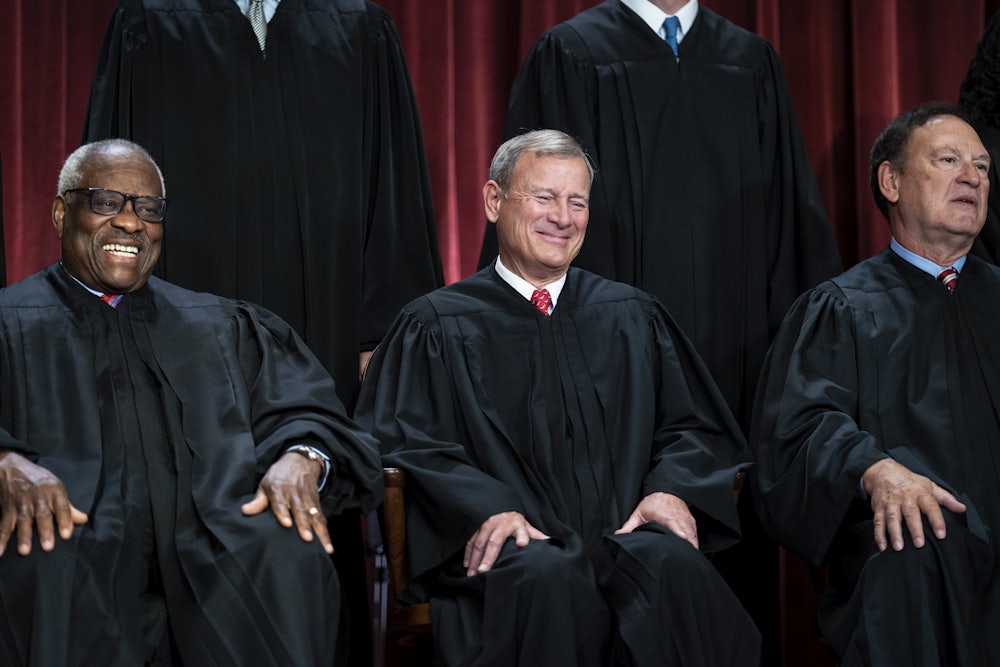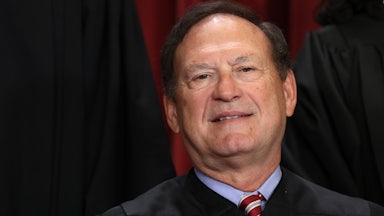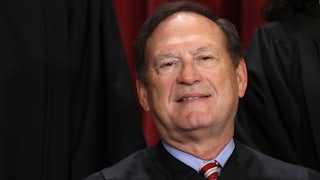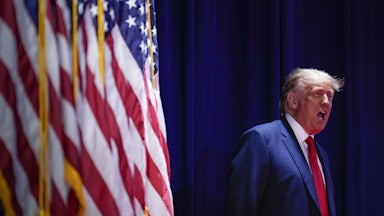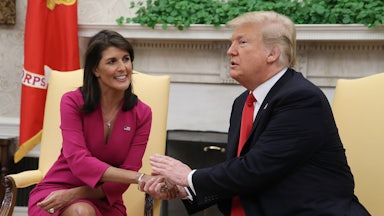A notable split is developing among the Supreme Court justices over the prospect of ethics reform, with two of the court’s nine members openly hostile to the reporting on ethics concerns.
One of them, Justice Clarence Thomas, whose relationships with various conservative billionaires and benefactors have brought him under intense scrutiny this year, amended his annual financial disclosure forms in August.
His lawyers released a statement at the same time denouncing as “left wing organizations with largely undisclosed supporters that stand diametrically opposed to his judicial philosophy” those raising concerns in the first place. “The attacks on Justice Thomas are nothing less than ridiculous and dangerous, and they set a terrible precedent for political blood sport through federal ethics filings,” Elliot S. Berke, his lawyer, said in the statement. “Justice Thomas’s amended report answers—and utterly refutes—the charges trumped up in this partisan feeding frenzy.”
Justice Samuel Alito, who like Thomas was the subject of ProPublica’s reporting over the summer, tried to front-run a piece about his Alaskan fishing trip with a conservative billionaire by publishing an unusual pre-rebuttal in The Wall Street Journal. In a later interview for that paper’s editorial section, he also brushed aside the possibility that Congress could enact ethics reform for the high court and said he only obeys current ethics laws because he wants to.
“I know this is a controversial view, but I’m willing to say it,” he told the Journal in an interview in July. “No provision in the Constitution gives them the authority to regulate the Supreme Court—period.” When the Journal asked if his colleagues share this view, Alito demurred. “I don’t know that any of my colleagues have spoken about it publicly, so I don’t think I should say,” the justice replied. “But I think it is something we have all thought about.” The Journal did not relay any remarks from Alito on possible internal reforms by the justices themselves.
If the court’s other justices share this combative approach, they aren’t saying so publicly. Justice Elena Kagan avoided a direct answer about whether Congress could enact a code of ethics for the justices but also appeared to reject Alito’s absolutist view. “It just can’t be that the court is the only institution that is somehow not subject to any checks and balances from anybody else,” she said at the Ninth Circuit Court of Appeals’ judicial conference last month. “I mean, we are not imperial.” Kagan said that it’s possible that Congress could go too far but that, at the same time, “we, too, are part of a system of checks and balances.”
It is impossible to predict the result of the Supreme Court’s internal ethics debate. The justices themselves rarely shed any public light on those deliberations. Since the ethics debates are part of the court’s internal rulemaking and not any specific case, they are also not obligated to write opinions about them for the public to read. Indeed, it is an open question whether that internal debate will actually result in anything.
The justices have no formal power over one another, only the ability to persuade and convince. Chief Justice John Roberts, for example, is the de facto leader of the federal judiciary, but he cannot compel another justice to recuse themself from a case or bind them in any other way.
Roberts remarked in the spring that the justices were considering ethics reforms, but that only underscored that his power is limited to starting a debate, not ending it. That does not mean his voice isn’t influential, of course. Both then and in past remarks, Roberts has emphasized letting the court self-regulate instead of allowing another branch to step in.
“I want to assure people that I’m committed to making certain that we as a court adhere to the highest standards of conduct,” he told the American Law Institute when accepting an award from them in May. “We are continuing to look at things we can do to give practical effect to that commitment. And I am confident that there are ways to do that consistent with our status as an independent branch of government and the Constitution’s separation of powers.” He did not describe the court’s internal debate any further, except to say that there was “cause for optimism.”
What they could do remains unclear. The Supreme Court does not have the internal discipline mechanisms that the lower courts occasionally use to sanction wayward members. All nine justices take part in every single case, so there is no mechanism to reassign them or remove them from specific ones against their will. And even if the justices agree to a code of conduct, there is nothing they could do to enforce it against one another if push came to shove.
In theory, eight of the justices could collectively decide to strip another justice of their vote in the most extreme circumstances. The Supreme Court took that extraordinary step just once in its history, when the other eight justices secretly agreed in January 1975 to punt any case in which Justice William O. Douglas cast a deciding vote to the following term instead of handing down a ruling. Douglas, who was 76 years old at the time, was partially paralyzed by a series of strokes and refused to retire despite—or perhaps because of—his deteriorating mental condition, forcing the court’s hand. (He eventually stepped down that November.) Beyond that exceptional collective step, however, the individual justices have no ability to substantively check one another.
More recently, close Roberts allies have echoed the self-regulation theme. “The chief justice spoke about that in May and said that we’re continuing to work on those issues, and that is accurate, we are continuing to work on those issues,” Justice Brett Kavanaugh told an audience of judges and lawyers at the Sixth Circuit Court of Appeals last week. “And I’m hopeful that there will be some concrete steps taken soon on that.” Kavanaugh and Roberts are frequent collaborators on the court, and Roberts reportedly persuaded him personally to join a key Voting Rights Act decision last term.
Justice Amy Coney Barrett, the court’s second-newest member, did not address the question of ethics reform when she spoke recently. But she also eschewed a combative stance toward public scrutiny of the court and its members. “Justices and all judges are public figures, and public criticism kind of comes with the job,” she told an audience at a Seventh Circuit judicial conference. “But I’ve been at it for a couple of years now, and I’ve acquired a thick skin, and I think that’s what public figures have to do; I think that’s what all judges have to do.” While she may not have meant this as a direct criticism of Thomas and Alito, it sharply contrasts with their approach.
I don’t want to overinterpret what the justices are saying. After all, they rarely share the court’s internal debates in public. The court’s nine members value their innermost discussions’ secrecy as both a practical means to freely discuss the cases before them and as an institutional way to bolster the court’s legitimacy. While the justices do speak on legal issues and past decisions to law students and the occasional reporter, they almost never draw back the curtain for the general public.
To that end, it’s not clear yet whether these public remarks fully reflect the stances that the justices are taking when talking amongst themselves. (As you may have gathered from a head count of the justices mentioned, not all of them have spoken publicly about ethics reform yet.) If this is the way the winds are blowing, however, then Thomas and Alito might find themselves in an uncomfortable position. It would be awkward, to say the least, for the two justices who’ve received the most scrutiny to be the ones most resistant to reform.
